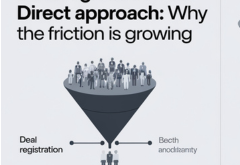Future belongs to the organizations, which are doing few things but doing it very effectively, according to the BFSI experts in the second edition of the CXO BFSI Automation Summit 2021. Themed on ‘Hyper Automation is the Digital Future,’ the exclusive platform for BFSI CXOs upheld that moving forward innovation and automation will be inclusive and be targeted towards customers. The online summit brought together over 1500 top IT Leaders from the BFSI fraternity to deep dive into the imminent challenges in BFSI and the best practices to overcome the same.
During his opening note on ‘Reimagining BFSI with Digital Opportunities and Innovation,’ Rajendran N, CEO, Indian Financial Technology & Allied Services (an RBI subsidiary) noted that innovations around automation have grown aggressively over the last 2-3 years, which is targeted towards driving customer experience and enable them use services seamlessly. “Moving forward, innovation and digitization must be inclusive and be targeted towards customers,” said Rajendran. Giving an example he highlighted that UPI has created huge changes in the financial service ecosystem. He listed three factors that worked in favor of UPI’s proliferation:
- Customer experience: UPI enabled customers to use their devices to authorize the payments; cards are no more required.
- User experience: UPI enabled use of minimal infrastructure to receive payments; just a QR code is required to get the ball rolling.
- Security: UPI enables end-to-end security of the card and personal details of the customers.
He added that new technology like AI, automation and RPA are being used to create new experiences for customers, new products/services, and enhance current service offerings. “These technologies also enable organizations to identify efficient and trusted partners and supply chain solution providers to build a reliable financial ecosystem of retailers and on-ground force.”
In his industry keynote on ‘Banking on the Future: Keeping up with the Financial Landscape,’ Sanjiv Bajaj, Joint Chairman and MD, Bajaj Capital, contended that connected industry will be the future of BFSI. “Future belongs to the organizations which are doing few things but doing it very effectively. Hence, master of all will not be the future,” shared Bajaj.
As customer experience is the key to moving ahead, social media is playing a crucial role in overall delivery. “Social media has democratized the voice of every citizen. While we understand that in most cases 90 percent of the customers are satisfied with the services. Efforts are required to satiate the 9 percent with a reworked approach. The remaining 1 percent can’t be satisfied even by God,” he elaborated.
Bajaj further highlighted that getting a space on customer’s mobile is an art that organizations need to learn. “We must focus on holistic approach to deliver services and catch the eyeballs among the customers. Today, customer decides how things need to be done and winner takes it all. If we don’t act today, someone else will take away all the opportunities.”
During his keynote address on ‘The Transformative Power of AI in Banking & Financial Services,’ Jaspreet Singh, Partner and National Leader, Client & Markets (Technology and Transformation), Grant Thornton Bharat, stressed that digital transformation has been the most used and abused word over the last couple of years. “When we talk about digital transformation, we talk about digital agility, maturity, incubation or entire organization being digital. As per a WHO report released in 2019, the probability that a pandemic affects more than 30 countries was just 7 percent. However, as we are 19 months in the pandemic, it has affected more than 180 countries forcing businesses to go digital. Covid-19 has propelled the digital transformation to the forefront.”
The focus is now how do we become more digital and agile as an organization. He underlines that with the use of AI and ML technologies, majority of banking experience has become digital; banks are taking decisions much faster. “In loan approval processing, it now take less than 5 minutes to take the decision against earlier norm of 7-10 days. In fact, in the micro-financing businesses AI and ML technologies are doing great job. Entire business processes in the BFSI are becoming more connected, evolved with next generation tools coming to the forefront. Banks are now accessible through any digital device,” Singh explained.
Singh added that BFSI organizations need to look at digital transformation and AI/ML technologies through a six-point agenda:
- Changing the Game: Understanding the new market dynamics and calibrating customer expectations.
- Digital Tech: Identifying and adopting the right technology capabilities to enable the digital transformation journey.
- Integrated Enterprise Architecture: Successfully integrating and managing legacy and new technology within an extended enterprise.
- Organizational Transformation: Re-invigorating the organizational models and systems to the new normal.
- Market – Global/Local: Selectively investing in markets and focus sectors; expanding locally to capture niche markets; and global aspirations and readiness-to-serve.
- Data & Analytics: Manage data models and real-time insights, and data governance.
Richard Heitmann, Vice President, Automation GTM, IBM, delivered his keynote on ‘Improving Business Growth with AI-Powered Automation.’ He stated that businesses that invested in technology have been able to survive and thrive and in many cases were able to improve their performance with high customer experience. “Leaders which are investing in digital transformation are making fundamental changes to their business. They are innovating and deploying digital systems as well as connecting and automating their systems across complex hybrid cloud environment. They are assuring application performance at lower costs with reduced downtime. They are doing this through AI-powered automation as it really connects business and IT. In addition, it maximizes revenue per employee and simplifies otherwise complex operations,” explained Heitmann.
He further added that organizations are turning to AI-powered automation to improve speed, utilization, and service delivery. However, automation can’t happen without proper integration. In fact, 70 percent of digital transformation projects fail due to a lack of integration quality, he concludes.
Moderating the panel discussion on ‘Empowering Digital Transformation with Intelligent Automation,’ Rajeev Seoni, Director, Digital Futurists Angels, and Former CIO, E&Y, mentioned that as the BFSI sector is going through a course of disruption which marks the emergence of the new gene of banking businesses, new agile business models and intelligent automation. “It’s a huge transformation that is going on in the industry with the large data generation, integrated and automated workflows. In order for the BFSI industry to scale up, it is imperative that they employ the use of intelligent automation,” said Seoni.
Since majority of people have been working from home, there was extensive demand for IT support which overwhelmed the IT team, shared Malcolm Ong, IBM Automation Leader, IBM Asia Pacific. “Hence, there was a demand for automating the response on the technology support requests. That’s where automation started to play a major role in redefining the processes,” he added.
Pandemic led to huge focus on automation in order to reduce dependencies on human interventions. “Automation made us run the show even when key people were not reachable. It also enabled faster go-to-market with lesser errors. In this scenario, AI played a vital role as it helped on bringing in lot of human intelligence to the processes. This enables us to be more predictive in terms of predicting growth of various sectors and modify our approach and strategies. Hence, predictive analytics enabled the fund managers to take crucial decisions more effectively,” stated A Shiju Rawther, Head – IT, SBI Mutual Fund.
In a move towards driving automation, NIIF Infrastructure Finance reviewed its data loss prevention process and realized that there are many logs that got created and the majority of them were false positives. “We got experts to read through logs and this enabled us to quickly classify the false positives and real threats. With this approach, we are now in a far better position to manage the threats. With automation, the majority of the logs with false positives get filtered out and we need to focus on very selective logs which pose real threats. In addition, we reduced repetitive tasks of comparing MIS reports by integrating intelligent automated system,” revealed Madhusudan Warrier, CIO, NIIF Infrastructure Finance.
Seoni further highlighted that organizations need to decide on what to automate and what not to automate. That’s the first step towards building intelligent automation architecture. This determines the benefits businesses would reap with their initiatives and hence would guide their focus areas.
“Businesses have lot of legacy processes and applications; hence, as we move towards digital transformation on the front-end, we need to check what processes at the back-end we could automate. We created a RPA Center of Excellence couple of years back and identified over 35 processes to be automated, which we executed gradually. As an organization, we are learning to take our automation journey to the next level. So far, we have automated the low hanging processes to redefine the customer experience and the overall service delivery,” divulged Prasanna Lohar, Chief Innovation Officer, DCB Bank.
By leveraging AI, BFSI organizations are enabling claims processing of motor accidents through customers uploading images through the mobile app. “AI engine assesses the claim based on the images and communicates the approved amount within 20 minutes. So what used to take over 3-4 days earlier now happens within 20 minutes. In addition, the bulk of the customer servicing is now taken up by the mobile app, WhatsApp, customer portal and AI-driven chatbot, against 80 percent of customer servicing driven by contact centers earlier,” underscored Dipu KV, President, Head Operations & Customer Service, Bajaj Allianz General Insurance.
Further, automation is enabling BFSI players to offer secured loans more effectively. “During the Covid-19 restrictions business managers couldn’t call upon customers for personal discussions and video interaction was the only option left. Automation enabled us to effectively manage video-based KYC. Hence, RPA, AI and automation played a decisive role in the housing finance industry to help us disburse loans and take timely decisions,” added Dominic Vijay Kumar, VP & CTO, ART Housing Finance.
Elaborating on the available solutions, Malcolm said, “During the pandemic, lots of people were looking for business loans, which overwhelmed the banks with a huge number of loan applications. We worked with banks to implement solutions infused with AI engine. It not only offers task automation but also offers OCR capability and a native chatbot. This enables banks to service customers even after bank working hours. The chatbot enabled with OCR allows customers to enquire about their loan status and upload documents in case of any particular requirement. This tool also offers end-to-end solutions for claims processing including data capture from documents, analyzing data and feed that into various applications.”
Offering his master class on ‘CX2.0 in Retail Banking,’ Harshit Desai, former Head, Customer Experience, Alliances (Partnerships), & Automation, Aditya Birla Finance, said that while banking is becoming more and more digital, experts opine it should become more human. “The amount of data which can be mined and the intelligence that can be created out of it is enormous. Most importantly, BFSI organizations must appreciate the privacy of each of the individual customers. These three points play major role in defining and building customer experience,” he shared.
BFSI organizations’ emphasis must be on leveraging data in a better way to create better products and services. “The focus should be on how the products or services are changing the lives of the customers. If we offer transactional banking then it’s not very memorable. CX 2.0 will expect technology to be warm and caring for the customers; where people look forward to interacting with technology tools. Currently, the first interaction with technology during a banking transaction is crude as we need to verify ourselves with OTP, passwords or biometric details. The CX 2.0 envisages technology to enable these transactions to be seamless and effortless. Moreover, relationship banking must graduate from a speech-driven faceless one to a digital avatar with face and personal connect. This will also build trust between customers and banks,” underlined Desai.
The summit converged with an evening of celebrations and acknowledging the achievements of the BFSI technology leaders through a slew of awards including CXO BFSI Tech Champion Awards, CXO Fintech Innovation Awards, and CXO BFSI Women Achievers Awards. The summit was supported by leading brands including IBM as the Presenting Partner, Data Management & Awards partner Veeam Software, BCP partner Citrix Systems, Security partner Kaspersky and Information System partner Orsus.
 Latest Technology News Today – Get Latest Information Technology Updates and Services Latest Technology News Today – Get Latest Information Technology Updates and Services
Latest Technology News Today – Get Latest Information Technology Updates and Services Latest Technology News Today – Get Latest Information Technology Updates and Services 









